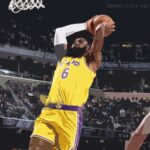The game of basketball is governed by a vast set of rules.
For the most part, these rules are the same for all competitive leagues, including the NBA.
For example, illegal contact during gameplay will result in a personal foul or worse (i.e. technical).
There are host of violations that exclude contact such as shot clock, backcourt and dribbling violations.
Dribbling involves the combination of ball possession and foot movement.
The most common dribbling violations are made up of travel, carrying and double dribble.
Each one of these illegal plays will result in the immediate possession turnover to the opposing team.
The term “double dribble” gives you an idea at what rule is being broken, so let me break it down further detail…
What is Double Dribble in Basketball?
In basketball, "double dribble" refers to a violation that occurs when a player stops dribbling the ball, then starts dribbling again with the same hand, or when a player uses both hands to dribble the ball at any time. Essentially, it involves halting the dribbling motion and then resuming it improperly.
For each individual possession, players are only allowed to begin and stop dribbling once.
When dribbling has stopped, the player must remain in place with their pivot foot planted on the floor.That is, once you collect the ball after dribbling, you are anchored in place by your pivot foot. You cannot lift or slide the pivot foot unless you are in the process of passing or shooting the ball.
Your non-pivot foot is freely allowed to be lifted and moved around your pivot foot as much as you desire.
A double dribble is called if you begin dribbling the ball a second time during the same possession.
If you pass, shoot or get stripped off the ball momentarily, any subsequent possession allows you to resume dribbling again.
Double Dribble vs Carry vs Travel in Basketball
The difference between a carry and double dribble can, at times, be very subtle.
That’s because the carry violation is due to a player pausing the dribble by allowing the ball to come to rest in one hand.
Immediately after the violation, the player resumes the dribble and is called for the carry.
In essence, the carry is visibly more of a fluid violation compared to the “start and stop” of a double dribble.
Meanwhile, a travel is called because the player took steps while dribbling has already stopped, or was never initiated to begin with.
Once the ball is gathered, players are allowed two steps before they must pass or shoot the ball on net.
If they hold onto the ball more than that, they will be called for travel.
Even if they realize their error and try to compensate by commencing the dribble, the travel violation will be whistled down.
Is Double Dribble ever Legal in Basketball?
The only time players are not in violation of double dribble is during a jump or loose ball situation.
Basically, they can gain possession of the loose ball by dribbling into their hands, gathering the ball and resume dribbling without being penalized.
The same applies if your opponent knocks the ball out of your hands after you stop dribbling the first time.
When the ball is knocked out of your hands, you can regain possession and start the dribble over.
The most talented players may even use this as a strategy, knowing they can recover the ball quicker than their opponent can.
That is, the player who’s already used up their dribble, hold the ball loosely so that their opponent can swat at it.
In the end, the same player releases the ball temporarily to allow to drop and immediately gain possession and start the dribble again.
In some cases, you’ll see the ball handler pass the ball to the body of an unsuspecting opponent, reclaim possession and resume the dribble legally.
Final Thoughts
Just like the carry and travelling, double dribbles would give an unfair advantage to the team in possession of the ball.
When the rules are strictly applied, theses violations are called immediately by the referees.
But since the game is very high intensity, you’ll see players getting away with the most obvious violations.
That’s because the referee’s view was obscured, or they were distracted by other potential violations on the court.
And to be clear, dribbling violations cannot are not reviewable by the referee nor by a coach’s challenge.
So, you’ll often hear from diehard fans that the game is rigged or that players get away with too many obvious non-calls.
Many will also claim that the referees are lax on certain violations in order to keep the game highly entertaining and fluid.
But, in reality, the game is extremely fast-paced and referees are required to make split-second decisions at every corner.
This likely leads to the occasional “missed calls”, which are more dramatic when the team in violation capitalizes on the situation immediately.
When it comes to double dribbling, I think personally think that most players do so accidentally.
However, it wouldn’t be surprising if players test the ref’s competency every so often.






